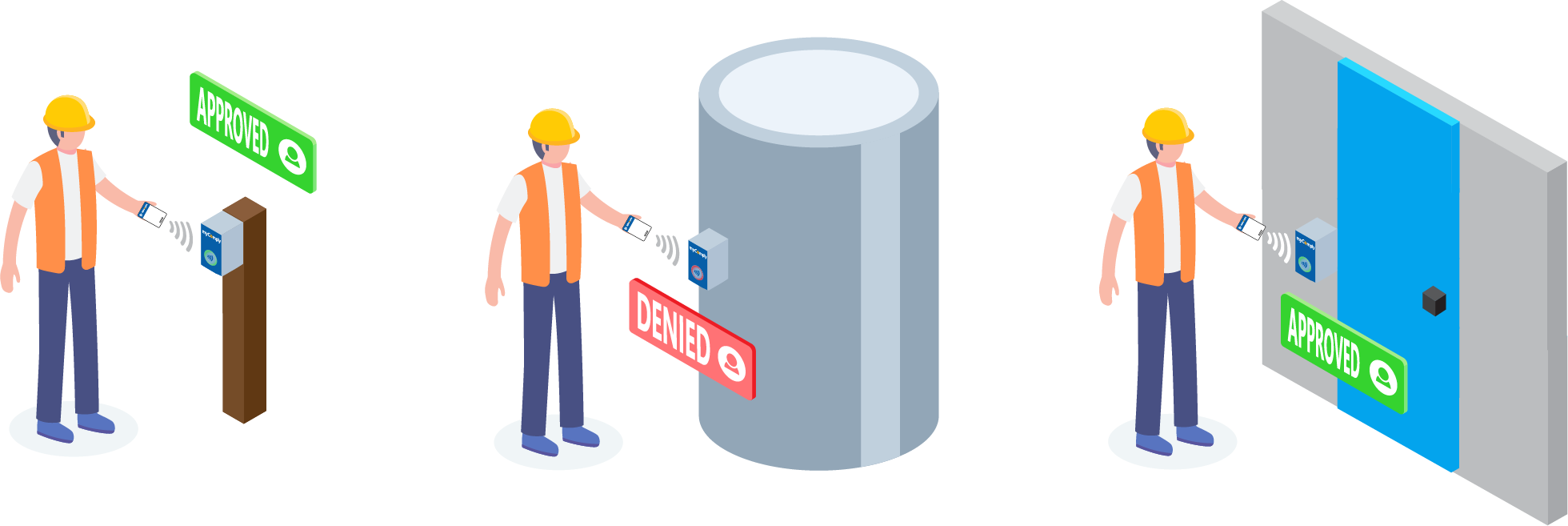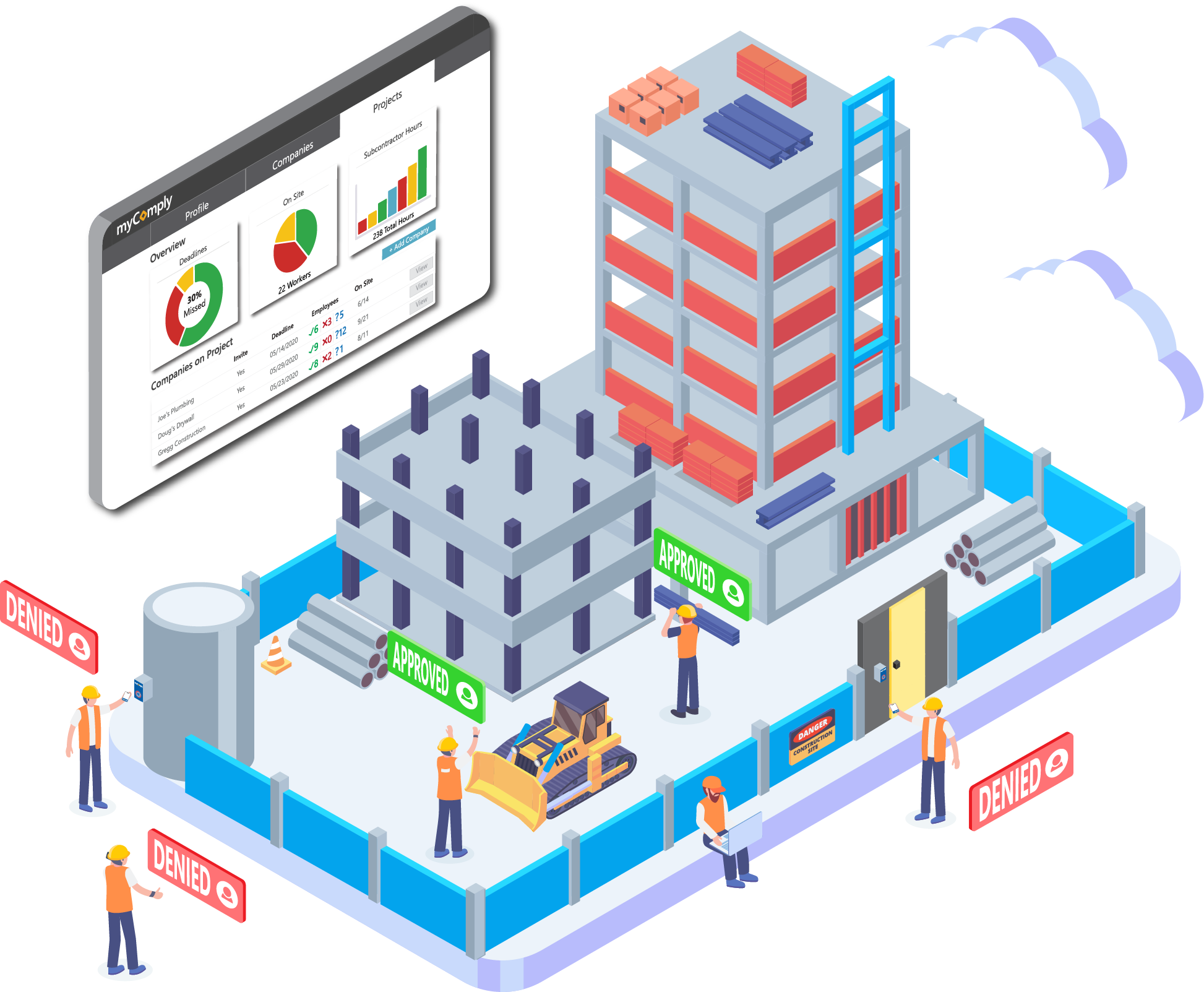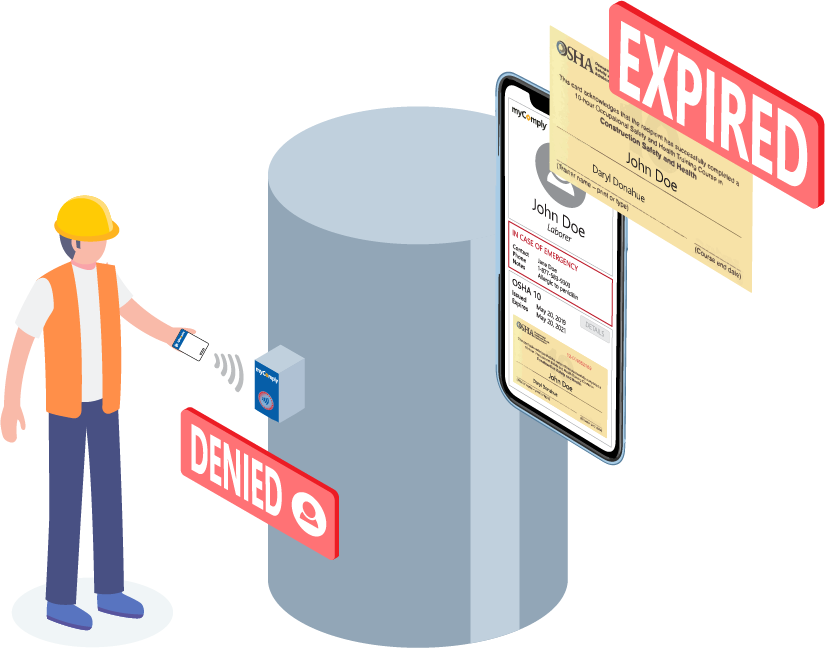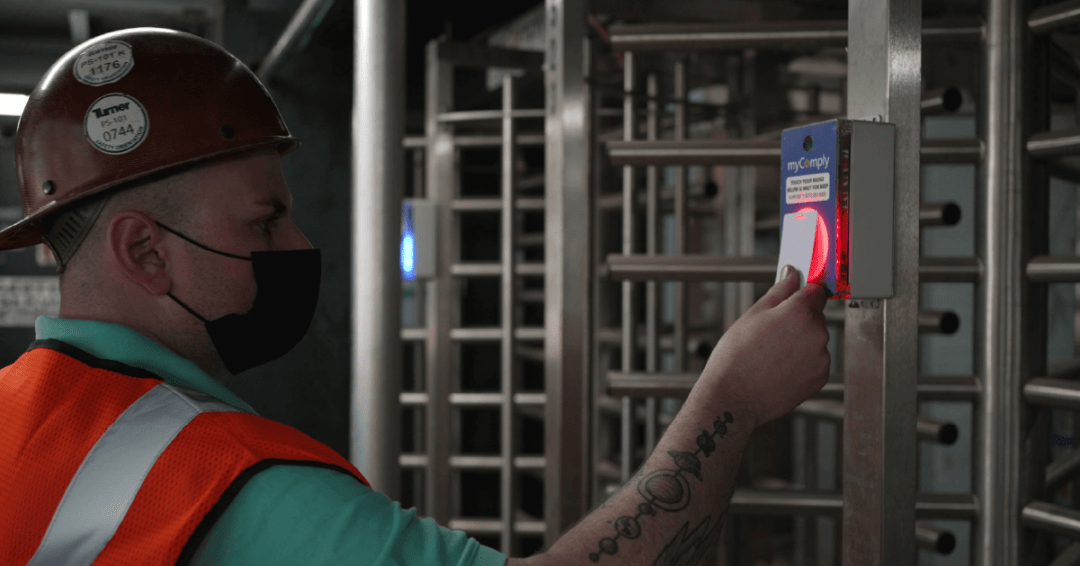Construction firms utilize construction site access control for a variety of reasons. Some are looking to secure equipment, building materials, or other physical assets on the site. Others might be more interested in defending the site from passerby traffic, unqualified workers, and pedestrian injuries, especially when building infrastructure in dense metropolitan areas.
Construction site access control is a critical component to managing a smooth project, but often contractors fail to recognize the significance that site access control solutions can have on their insurance arrangements.
Why is the relationship between your construction site access control provider and your insurance provider important? We will cover this topic extensively in the following article and will outline what you need to consider when selecting an access control solution for construction sites.
Table of Contents
- What is Access Control in Construction?
- Where Construction Site Access Control is Most Important
- Two Major Things Access Control Protects on Construction Sites
- Four Major Insurance Coverages that Construction Site Access Control Influences
- Insurance Key Takeaway
- World-Class Access Control Solutions for Construction Sites
- myComply Starter Kit & Demo Booking Link
What is Access Control in Construction & How Does it Differ?
To put it simply, access control solutions in construction are like any other form of access control, they ensure that personnel with authorized access can enter the site.

So, how is construction site access control any different than access control to something like an office building? The stakes are much higher in construction and unauthorized access to a site has the potential to lead to much larger consequences.
Unauthorized access to a high-risk, highly dangerous construction site can lead to accidents and other incidents on a site that the owner (or general contractor) is liable for. All construction sites pose an elevated level of risk; therefore, it is important that individuals who are not qualified to be on the site do not gain access. This means both public passerby traffic, and unqualified construction workers.
In construction, the only individuals who should be allowed on a site are the ones that a general contractor or managing construction firm has given the green light to. This means:
- workers with expired certifications should NOT be on-site
- sub-trades with insurance lapses or insufficient insurance documentation should NOT be on-site
- workers who have not yet completed their orientation (both site-specific and other) should NOT be on-site
It is imperative that workers on a construction site are qualified, and that is why access control solutions for the construction industry must be considered as different from your standard building solution. We will discuss exactly why insurance providers are rewarding contractors who can display a qualified workforce and the impact that is has on coverage like workers’ compensation.

Environments Where Construction Site Access Control is Most Important
Construction site access control is most effective and most important in densely populated areas. A secure jobsite is important on every construction project but is often more difficult to achieve on a site located in lower Manhattan vs. a site that is in the rural Midwest countryside.
When there are people around, the risk for a general contractor, developer, or site owner is far greater. Risk can come in a variety of forms, including risk of theft, injury, property damage, or natural disaster. In this case, many of the risks that a construction site faces in a busy urban center are reduced substantially with a perimeter around site and airtight access control measures.
The 2 Major Things Construction Site Access Control Protects
Access control is used to protect the site during construction. Of course, there are many stages of construction, and some stages pose higher levels of risk than others. No matter the building stage, the two major things that access control solutions in construction protect are:
1. Possessions
2. People
Insurance providers care about both areas of protection, but for entirely different coverages. Possessions and property are insured but are covered through builders risk insurance, also known as course of construction insurance. The insurances that protect or cover accidents related to personnel on-site are general liability and workers’ compensation insurance.
The 4 Major Insurance Coverages that Access Control Influences
Along with protecting possessions and people on-site, comes detailed insurance arrangements that are outlined in relation to construction projects. When access control is involved on a project, it can have a significant impact on the way that underwriting teams prepare your insurance arrangements. The four major insurance coverages that are impacted by access control are:
1. Builders Risk (or Course of Construction) Insurance
2. Commercial General Liability (CGL) Insurance
3. Workers’ Compensation Insurance
4. Inland Marine Insurance
When you can showcase proactive or innovate risk-reduction measures your insurer can offer better rates and smaller premiums. Access control is a risk-reduction measure that needs to be considered in your insurance arrangements.
Don’t believe us? We’ll connect you with one of our insurance partners to assess your insurance needs and show you the impact of access control solutions on your costs. Get in touch!
1. Builders Risk Insurance
Builders risk insurance is often referred to as a variety of things: builders risk insurance, course of construction insurance, or sometimes noted as construction all risk insurance. This coverage ensures that all buildings and structures are protected during construction.
The biggest difference between builders risk insurance and typical commercial property insurance packages is that this coverage focuses on protecting the insured during construction. It is named appropriately, “builders risk” protects the builder from property related risks during the construction process.
In most cases builders risk coverage will cover:
• Damage to building materials
• Damage to foundation
• Damage to temporary structures used for construction (like scaffolding)
• Damage to landscaping
And, in most cases the damages that occur to the list above come in the form of:
• Fire
• Weather
• Vandalism
As a baseline, this is the best way to explain builders risk insurance without getting too granular. Insurance coverage can be expanded, and “premium coverages” are offered if a contractor or asset owner wishes to extend their coverage.
Builders Risk Insurance & Its Relation to Construction Site Access Control Solutions
Access control greatly minimizes the chance of damages from a variety of causes. Often, something like a fire occurs due to vandalism/arson or an unqualified worker operating “hot-work.” Your access control system can minimize the likelihood of both trespassers on-site and unqualified workers performing unsafe labor.
Talking with your insurance provider about your access control solution can provide you instant insurance savings. Not to mention that if you have used an access control provider for some time, you have already realized the benefit of less on-site damages, leading to better insurance rates along the way.
Unauthorized access is never a good thing in the eyes of your insurance provider, and the best way to protect your site from unauthorized foot traffic is a trusted access control solution.
2. Commercial General Liability (CGL) Insurance
Commercial General Liability insurance is sometimes also called contractor liability insurance and provides liability coverage to contractors in the case of bodily harm and some property damage instances as well. Often each contractor on a project (both sub-trade and general contractor) will have their own CGL coverage.
Wrap-up insurance arrangements will not require that each contractor has their own coverage. In this type of insurance arrangement, the site owner or general contractor will take responsibility to insure all parties involved on the project.
In many states and regions, a minimum level of CGL coverage is mandated by law. Requirements like this work to protect all parties involved during construction and distribute liability in the case of an accident on-site.
Although CGL coverage usually covers a broad array of damages, here are the main damages to recognize:
• Damage from faulty workmanship
• Job-related injury
• Advertising Injury/Defamation
The main reason any contractor relies on CGL insurance is to ensure they are covered if their workers make mistakes in their workmanship. Faulty workmanship often leads to litigation and drawn-out legal battles.
Here are the types of organizations that generally acquire some level of CGL insurance for construction activity:
• General contractors
• Developers
• Remodeling companies/contractors
• Trades/Subcontractors (electrical, plumbing, masonry, etc.)
CGL Insurance & Its Relation to Construction Site Access Control Solutions
Certain access control solutions in construction greatly minimize the chance of damages caused by faulty workmanship. This may seem strange, because faulty workmanship can occur at any point in time and accidents can/do happen, but a qualified workforce is far less likely to make mistakes. When construction site access control solutions can reference a worker’s tickets, certifications, and qualifications before they arrive on-site, the work performed on-site will be of a higher quality.
For example, if a jobsite is lending keys (or fobs) to all workers to get on the jobsite, but not referencing their qualifications, they might be letting workers with expired tickets or a lack of training on the job. These workers are far more likely to complete work at a lower standard.
If that same site adopted an access control solution that denied entry to workers without the proper qualification or expired training, they would ensure all work performed on-site was completed by qualified individuals.
A great real-world example is your driver’s license and the impact that qualified drivers have on accidents involving motor vehicles. If all drivers on the road have an up-to-date, valid driver’s license, then it is far more likely the roadway is safe compared to a road where any driver is allowed to operate a vehicle. Likewise, on your jobsite, it is far more likely that work will be performed to sufficient standard/code when all workers have valid, up-to-date qualifications.
Unqualified workers should never slip through the cracks. If you can prove to your insurance provider that your workforce is ALWAYS going to be skilled, with up-to-date training, and qualified based on–site safety standards, then you are much more likely to negotiate more competitive insurance rates.

3. Workers’ Compensation Insurance
Workers’ compensation insurance protects construction firms for injury costs and accident remediation while on the job. A common misconception is that workers’ comp only covers costs directly related to the injured worker, however, this is just part of what workers’ compensation insurance covers. The following areas are all protected under conventional workers’ comp coverage:
• Medical expenses
• Recovery costs
• Legal fees
• Missed wages
• Funeral costs and death benefits (worst case scenario)
Of course, workers’ compensation insurance is not exclusive to the construction industry, but the high-risk nature of construction often means an elevated chance of accidents and injuries on the job. Like CGL insurance, workers’ compensation insurance is often required by law.
Workers’ Comp Insurance & Its Relation to Construction Site Access Control Solutions
Let’s reference back to the example around an access control solution that ensures a qualified workforce on a construction site vs. one that does not. The site that is allowing qualified workers on-site and denying entry to workers who do not meet site safety standards is far less likely to have an accident or incident.
In the case of CGL insurance, the accidents are in relation to quality of work. But, in the case of workers’ compensation coverage, accidents are related to physical injuries (or death) on a construction site. In both scenarios, access control systems that guarantee qualified workforces are creating safer sites and earning insurance savings.
Like most insurance, your insurance costs go down over time with less claims. Start influencing safer work on the jobsite with a construction site access control solution that ensures qualified workers.
Looking for more ways to save on workers’ compensation claims, we’ve got you covered! Visit our post: How to Reduce Workers’ Compensation Claims in Construction
4. Inland Marine Insurance
Inland marine insurance can be a confusing name for construction insurance, but this insurance coverage’s name originates from coverage for ocean-trafficked materials and vessels. While this coverage no longer exclusively coverage the marine industry, the foundation of the coverage remains the same. Inland marine coverage includes equipment insurance and offers protection from theft or damage to tools and equipment.
Here is what inland marine insurance covers:
• Contractor’s tools and materials (drills, saws, wood, etc.)
• Mobile equipment (forklifts, cranes, excavators, etc.)
• Technology equipment (computers, tablets, servers, etc.)
Here are the scenarios in which this coverage would be used:
• Equipment is stolen from site
• Tools or materials are damaged during transport
Although the name is deceiving, it is simple to understand where this coverage comes into play during the course of construction. Building materials and equipment on-site are always at risk of being damaged or stolen, whether it be from construction workers or passerby traffic.
Inland Marine Insurance & Its Relation to Construction Site Access Control Solutions
Theft is far less likely to occur on a construction site that is tightly secured with a perimeter fence and robust access control. Your insurance provider should immediately reward you for a tightly sealed jobsite, and the likelihood of theft or damage from mischief on-site (typically after hours) is far less when the site is secure.
Your access control system is your 24/7 automated security and is constantly keeping unwanted individuals from accessing the site. In turn, the insurance provider is going to have to pay out less in coverage if the insured party has an elaborate access control system on their jobsite. It is incredibly important to have a conversation about access control with your insurance provider.
Insurance Key Takeaway
No matter the insurance coverage, the key thing to note is that access control solutions in construction offer savings in the short-term and the long run. Short-term negotiations that specify the use of access control can offer immediate savings on insurance rates. Long-term savings come in the form of reduced premiums because of fewer insurance claims, something your access control solution will provide over the long-run.
Whether you are negotiating new insurance arrangements or have existing insurance, it is important to involve your insurance team in the procurement process of access control technology.
World-Class Access Control for Construction Sites
myComply offers world-class construction site access control solutions for contractors across the globe. We work with over 5,000 contractors to ensure a qualified workforce is present on all construction sites and have built a solution around the needs of the world’s largest contractors.
Our clients work in high-risk environments every day, and our solution brings peace of mind to firms managing construction sites. Listen to one of our New York City-based contractors, Ryder Construction, who trusts myComply for data and access control on busy Manhattan-based builds:
View Ryder Construction Case Study
myComply’s system is not only trusted by contractors but some of the world’s largest insurance providers and underwriters trust myComply for reliable data related to insurance arrangements. Construction technology, like myComply’s construction site access control, is changing the way insurance companies and contractors do business.
“Construction technology is the next frontier of risk management. Using technology and leveraging data, contractors have the potential to significantly lessen risks and boost profitability. By supporting their tech adoption journey through partnership, innovation and invention, AXA XL is determined to help the industry move forward.
In time, as the entire construction industry risk profile begins to shift, losses will decrease, and the insurance costs associated with those risks should follow. This could happen sooner than we think. Technology will soon be a tables stakes way of doing business in construction. I equate it to the way safety has advanced in the last few decades. I can recall a time when having an EMR below 1.0 was all that was needed to be considered a safe contractor.
Today, the many safety practices and programs across the industry raised the bar higher for everyone – meaning you need a much lower EMR to be considered safe today, which ultimately impacts your insurance costs. Soon, construction technology will no longer “innovative” but merely the way we build. Jobsites will be less risky. Workers will be better protected. Profits will improve. And insurance costs will reflect contractors’ enhanced risk profiles.”
“Insurance is meant to be a tool to help businesses operate freely, effectively, and efficiently. The use of technology in construction serves the same purpose as a driver of a reduction in both overhead and risk in their business. It is a relationship of synergy and alignment.
Technology helps manage job sites, detect injuries, prevent accidents, and improve the quality of products. The deployment of the technology helps lower the chance of loss for the company and in turn the insurance carrier covering them. This allows the carrier to consider a lower insurance premium, which in turn helps lower the overall cost of the risk transfer for the business.”
The largest insurance companies in the world are starting to see why your technology stack is important, and how it can influence your insurance costs. Explore how myComply can help transform your jobsite with it’s access control solutions and realize larger profit margins by involving myComply in your insurance arrangements.

Get a starter kit or arrange a pilot project with myComply to put our construction site access control solution to the test! Talk to us.




A revolutionary new approach to access for fabric maintenance in offshore oil & gas, refinery jetties and railway bridges.
Replace suspended scaffold, Underdeck Access & Netted Safety Solutions with the WEB Deck. WEB Deck offers the same stability and other features as conventional and
system scaffolding with a quarter of the install/de-install time. It delivers massive improvements in safety,
logistics and operations. We believe that the quality and value within your work or constructions area is essential to its success!
For More Details or Enquiry visit website : http://www.web-international.com or follow blog https://web-system-deck-net-catch-map.blogspot.com/